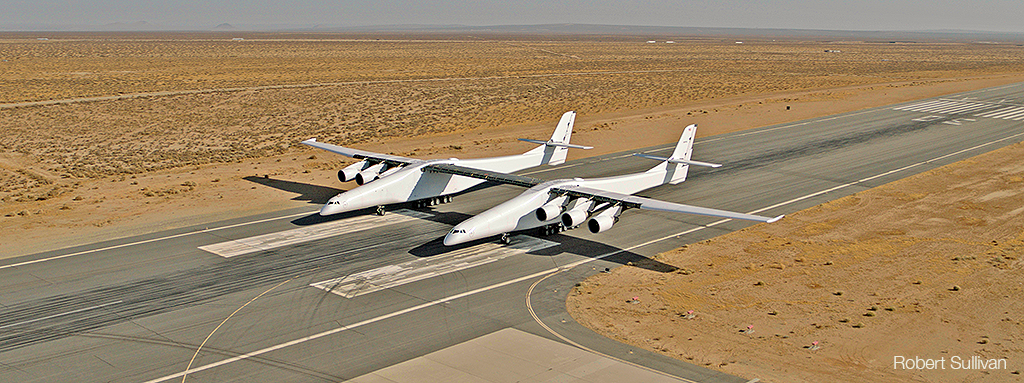After cancelling its first flight in 2016 due to engine design and power problems, on 13 April the world’s largest aircraft carried out its first flight. It remained in flight for two and a half hours, reaching a speed of 304 km/h and an altitude of 5,185 metres. Among its design specifications, the reinforcement of its central wing stands out, as it enables the aircraft to support around 227,000 kg, enough to transport multiple launch vehicles.
The world’s largest aircraft, the Stratolaunch, is just one link in a tough race towards achieving a place in an ever-growing market of orbital launches.
Paul Allen, co-founder of Microsoft, founded Stratolaunch Systems in 2011, with the aim of optimising the costs of an orbital launch. The company designed a 117-metre jet aircraft with six engines (originally designed for the Boeing 747) and a double fuselage, capable of carrying a rocket to an altitude of around 10,600 metres. At this point, the rocket will separate from the transport aircraft and complete its ascent into Earth orbit using its own engines.
With this aircraft, Stratolaunch Systems has achieved a new mobile launch platform that allows cargo and people to be placed into orbit in a cheaper and more routine way. It also has much lower maintenance costs, and avoids the costly traditional method of using multistage rockets. Furthermore, it minimises the dependence on weather conditions, and circumvents what was almost an obligation to take off from the equator before diverting the trajectory to reach the desired point.
According to Paul Allen, taking an astronaut to the international space station is 70% cheaper with the Stratolaunch. What’s more, the aircraft would return to the ground in perfect condition, and would require little time before it was ready for its next mission.
However, this is not such a novel concept, as there have been many prior projects that have made progress in this area. For example, in Russia there were projects such as the air launch from the An-124 Ruslan, the Burlak with a Tu-160, Ishim with the MiG-31 and Svityaz with the An-225 Mriya. However, none of these projects prospered.
The company Orbital Sciences developed a similar project that has been in operation for more than 20 years. It consists of Pegasus rockets launched from the Stargazer: a Lockheed TriStar modified for the purpose. A total of 43 launches were carried out, 40 of which were successful. However, all of these took place at the beginning of the programme, and in the last ten years only three launches have been carried out, which shows that this project is being kept afloat merely for scientific and technological purposes. The commercial failure of this system has several explanations. First and foremost, there is a performance limitation in launches with Pegasus rockets: a maximum of 450 kilos into low orbit. Added to this is the high cost of the launch, which in 2014 amounted to 56 million dollars. By comparison, launching the Russian Proton-M rocket, which can transport 23,000 kilos into the same orbit, costs 65 million dollars. This capacity is important, because operators of small satellites often share costs by launching several devices with the same rocket, thus achieving a reduction in costs.
The competitiveness of this market means that the Stratolaunch’s future is not entirely clear. Even though it is a young company, it took a relatively short time to develop the project. It was announced in 2011, and by 2017 the aircraft was being presented to the public.
One point of uncertainty is the fact that the project is suffering a lot due to carrier rockets. A collaboration with SpaceX was initially planned, but in 2012 Elon Musk’s company withdrew from the programme.
There was also a collaboration with Orbital Sciences that planned to develop the Pegasus II rocket, which would be capable of launching up to six tonnes into low orbit. However, the development has not been fruitful. In fact, in 2016 they proposed an idea that was not easily marketable: launching three conventional Pegasus rockets with each flight. Considering that in the last ten years only three such rockets have been launched, this does not seem like a good idea.
Probably the only thing keeping the Stratolaunch programme afloat is the fact that the company is cooperating with NASA in the development of its own space rocket, with a payload of 3.4 tonnes. Although its prospects may seem uncertain, the project might succeed thanks to the surge in satellite constellations, which are planned due to the development of satellite Internet.
The OneWeb project is predicting the launch of more than 600 satellites; Starlink SpaceX will launch 1,528 satellites, with the option of increasing the number to 12,000; and Project Kuiper Amazon plans to put 3,236 space devices into orbit.
In such a large market there could be room not only for Stratolaunch, but also for Richard Branson’s Virgin Orbit project, which has a system for launching small satellites: the LauncherOne. It is a two-stage rocket that can reach altitudes of up to 10,700 metres thanks to a customised Boeing 747-400.
NASA already has two Boeing 747s modified for transporting space shuttles, but only to landing and launch sites. They do not have the capacity to take them into space, as they only reach altitudes of 5,000 metres when carrying the shuttle.
Another possibility could come from the defence sector. The U.S. Defense Advanced Research Projects Agency (DARPA) announced the upcoming Launch Challenge, which three companies will participate in. Participants will be informed of the launch site several weeks in advance, and will be given the launch cargo a few days in advance. This operation will be carried out several times. In this way, the military will simulate situations in which they have to deal with unforeseen circumstances quickly and in an operational manner.
There is also the multimillionaire Elon Musk’s SpaceX, with its reusable two-stage Falcon vertical rockets. This company actually has its sights set even higher; specifically, on the space race to send people to Mars.
There is no doubt that space is no longer an area that is exclusively limited to large national agencies, with massive technological capacity and huge budgets to tackle large-scale projects. Private enterprises have already thrust themselves into the aerospace world, and they are here to stay.



